


Yellow Wax Beans
Estimated Inventory, 10 lbs : 2.05
This item was last sold on : 03/11/25
Description/Taste
Yellow Wax beans are a stringless vegetable that descends from the common Green bean. They have a long, skinny shape with tapered ends that measure about 10 to 15 centimeters long. The cornflower yellow pods have a thin, velvety skin with a satin finish and faintly waxy texture. The inside of the pod is smooth and slightly spongy, containing multiple light green beans. Yellow Wax beans have a mildly grassy scent. Their taste is slightly grassy with sour undertones and notes of natural saltiness.
Seasons/Availability
Yellow Wax beans are available year-round with a peak season from summer to early fall.
Current Facts
The botanical name of the Yellow Wax bean is Phaseolus vulgaris and it is a member of the Fabaceae family. “Wax” is a terminology from New England that refers to any yellow bean regardless of how waxy it actually is. One of the most famous Yellow Wax bean varieties is the Beurre De Rocquencourt Bush Wax bean. It comes from the rich farming region of Rocquencourt, France. There are approximately 130 types of string beans and they come in various colors including green, purple, red, and yellow. The commercial variety of string beans that we’ve come to know are technically immature. If these seeds and pods continue to mature, they become too fibrous to eat.
Nutritional Value
Yellow Wax beans are a source of vitamins A and C, which are important for skin and bone health, iron absorption, immune function, and healthy vision. They contain iron and manganese, nutrients that help prevent anemia, support energy levels, and aid in the processing of cholesterol, carbohydrates, and protein. Yellow Wax beans contain fiber to help control hunger and blood sugar, promote digestion, and prevent conditions like constipation, diverticulitis, and hemorrhoids.
Applications
Yellow Wax beans can be eaten fresh, baked, boiled, steamed, or fried. They can be used as a substitute for recipes that call for green or purple beans. Yellow Wax beans can used in bean salads, soups, stir fry, and casseroles. They can be smothered in a rich brown butter or bécahmel sauce or paired with proteins like poached lobster, tuna, pork belly, roasted chicken, barbequed salmon, ribeye steak, beef tenderloin, and filet mignon. Yellow Wax beans can preserved by storing in a can or blanched and pickled with spices. Yellow Wax beans pair well with a variety of foods, including almonds, artichokes, asparagus, Parmesan, feta, goat cheese, chicory, chiles, crème fraîche, garlic, hazelnuts, leeks, lemons, mushrooms, onions, oranges, pine nuts, prosciutto, shallots, tomatoes, and Worcestershire sauce. Yellow Wax beans are complemented by herbs like basil, dill, mint, nutmeg, oregano, parsley, rosemary, dill, and tarragon. Fresh Yellow Wax beans should be refrigerated and stored in a sealed container. Just prior to cooking, rinse and remove the tips from the stem.
Ethnic/Cultural Info
One of the most prolific varieties of this bean is the Cherokee Wax Yellow bean. It can produce considerably high yields in less than two months and is resistant to adverse weather and many plant diseases. Cherokee Wax Yellow beans were researched by Clemson University and became commercially available to the public in 1947. Another popular string bean that produces yellow hues is the haricot bean. This variety had been a long-time staple for Central and South American Indians by the time Christopher Columbus arrived in the New World. Seeds of the Haricot bean have been traced back 8,000 years in Peru. Though humans have been eating immature bean pods for centuries, stringless varieties like Yellow Wax beans have only been cultivated for about 100 years.
Geography/History
Yellow Wax beans are ancestors of the common green bean, which is native to Central and South America. They thrive in temperate climates and are grown in gardens and commercial farms rather than in the wild. Yellow Wax beans started to spread worldwide when they were brought from Algeria to France in the 1840s. Since then, many varieties of Yellow Wax beans have been developed in both Europe and the Americas. Though not as common as the green variety, Yellow Wax beans can be found at grocery stores, farmers markets, and in home gardens.
Featured Restaurants
Restaurants currently purchasing this product as an ingredient for their menu.
| Campo Gourmet | San Diego | 619-719-6924 |
| Ridgeview Health Center | San Diego CA | 858-293-3950 |
Recipe Ideas
Recipes that include Yellow Wax Beans. One

















